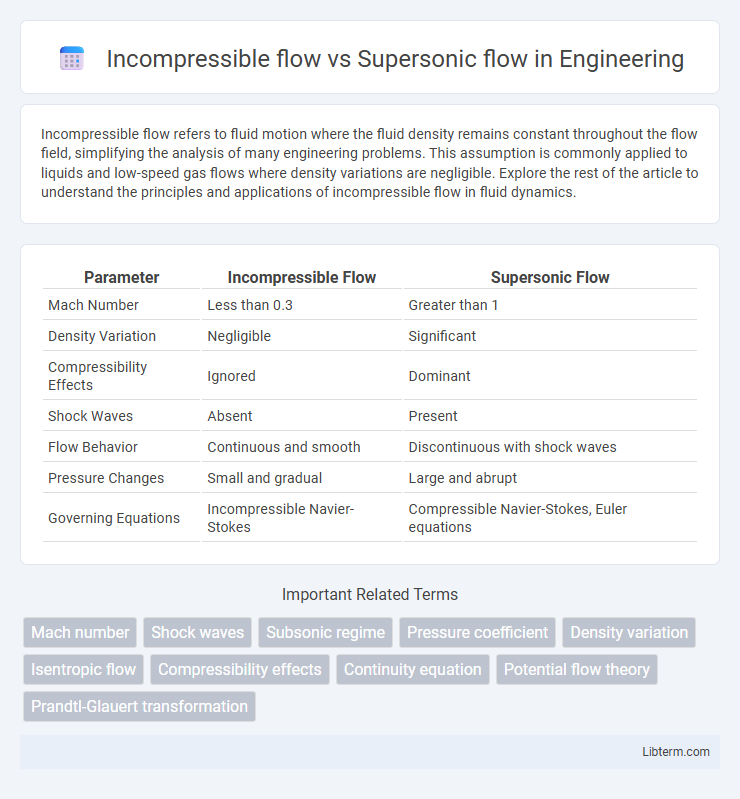Incompressible flow refers to fluid motion where the fluid density remains constant throughout the flow field, simplifying the analysis of many engineering problems. This assumption is commonly applied to liquids and low-speed gas flows where density variations are negligible. Explore the rest of the article to understand the principles and applications of incompressible flow in fluid dynamics.
Table of Comparison
| Parameter | Incompressible Flow | Supersonic Flow |
|---|---|---|
| Mach Number | Less than 0.3 | Greater than 1 |
| Density Variation | Negligible | Significant |
| Compressibility Effects | Ignored | Dominant |
| Shock Waves | Absent | Present |
| Flow Behavior | Continuous and smooth | Discontinuous with shock waves |
| Pressure Changes | Small and gradual | Large and abrupt |
| Governing Equations | Incompressible Navier-Stokes | Compressible Navier-Stokes, Euler equations |
Introduction to Fluid Flow Regimes
Incompressible flow assumes constant fluid density, typically valid for low-speed flows with Mach numbers below 0.3, where density variations are negligible. Supersonic flow occurs at Mach numbers greater than 1, characterized by the presence of shock waves and significant changes in pressure, temperature, and density. Understanding these distinct fluid flow regimes is essential for accurate aerodynamic modeling and the design of applications ranging from aircraft to propulsion systems.
Defining Incompressible and Supersonic Flow
Incompressible flow refers to fluid motion where the fluid density remains constant, typically applicable to liquids and low-speed gas flows with Mach numbers less than 0.3, ensuring negligible compressibility effects. Supersonic flow occurs when the flow velocity exceeds the speed of sound in the medium, characterized by Mach numbers greater than one, resulting in significant changes in fluid density and the formation of shock waves. The fundamental distinction lies in density variation; incompressible flow assumes constant density, while supersonic flow involves compressible fluid dynamics with rapid density changes.
Key Differences in Flow Characteristics
Incompressible flow assumes constant density, typically applicable at low speeds below Mach 0.3, where pressure changes do not significantly affect fluid density. Supersonic flow occurs at speeds exceeding Mach 1, causing shock waves and abrupt changes in pressure, temperature, and density, leading to compressibility effects. Key differences include density variation, flow velocity relative to sound speed, and the presence of shock waves in supersonic regimes which are absent in incompressible flows.
Governing Equations for Each Regime
Incompressible flow is governed primarily by the continuity equation *u = 0 and the Navier-Stokes equations without density variations, assuming constant fluid density. Supersonic flow requires solving the compressible form of the Navier-Stokes equations along with the energy equation, incorporating variable density, pressure, temperature, and shock wave effects. The compressible governing equations include the Euler equations or Reynolds-Averaged Navier-Stokes (RANS) equations with additional terms for shock capturing and entropy changes.
Mach Number: The Deciding Parameter
Mach number serves as the critical parameter distinguishing incompressible flow from supersonic flow, with values below 0.3 typically indicating incompressible conditions where density changes are negligible. Supersonic flow occurs when the Mach number exceeds 1, causing significant compressibility effects, shock waves, and drastic pressure variations. Understanding the Mach number's impact on flow behavior is essential for aerodynamic design and predicting flow characteristics in aerospace applications.
Pressure and Density Variations
Incompressible flow assumes constant density throughout the fluid, resulting in negligible pressure variations affecting density, which is typical at low Mach numbers (below 0.3). Supersonic flow, occurring at Mach numbers greater than 1, features significant pressure changes causing large density variations due to compressibility effects, especially across shock waves. These density variations directly impact flow properties such as temperature and velocity, making compressibility essential in supersonic flow analysis.
Effects on Engineering Applications
Incompressible flow assumptions simplify fluid dynamics calculations, making them ideal for low-speed engineering applications such as water supply systems and HVAC design, where density changes are negligible. Supersonic flow involves shock waves and significant density variations, critically affecting aerospace engineering by influencing the design of aircraft wings, jet engines, and supersonic nozzles to manage high-speed compressibility effects and thermal stresses. Understanding these flow regimes enhances performance optimization, structural integrity, and safety in various engineering fields by enabling accurate modeling of fluid behavior under different velocity conditions.
Flow Visualization and Diagnostics
Flow visualization techniques for incompressible flow emphasize methods like dye injection, smoke trails, and particle image velocimetry (PIV) to capture velocity fields and streamline patterns, revealing low-speed fluid behaviors with negligible density variations. Supersonic flow diagnostics heavily rely on shock-sensitive techniques such as schlieren photography, shadowgraph imaging, and laser Doppler velocimetry (LDV) to detect shock waves, expansion fans, and compressibility effects inherent in high-speed flows. Advanced computational fluid dynamics (CFD) combined with high-speed imaging enhances the analysis of both flow regimes by providing detailed quantitative and qualitative insights into flow structures and transitions.
Challenges in Modeling and Simulation
Modeling incompressible flow involves challenges such as accurately capturing vortex dynamics and pressure distributions due to the constant density assumption, which simplifies mass conservation but complicates momentum equations. Supersonic flow simulation requires handling shock waves, discontinuities, and rapid changes in thermodynamic properties, demanding advanced numerical schemes like shock-capturing methods to ensure stability and accuracy. Both flow regimes necessitate high-resolution meshes and adaptive algorithms to resolve complex flow features and ensure convergence in computational fluid dynamics (CFD) models.
Summary: Selecting Appropriate Flow Assumptions
Incompressible flow assumptions are suitable for fluid motions where density changes are negligible, typically at low Mach numbers below 0.3, making them ideal for liquids and low-speed gas flows. Supersonic flow models become essential when dealing with speeds exceeding Mach 1, where compressibility effects dominate and shock waves form, requiring compressible flow equations for accurate analysis. Selecting the appropriate flow assumption hinges on Mach number evaluation and the significance of density variations to ensure precise aerodynamic and fluid dynamic predictions.
Incompressible flow Infographic

 libterm.com
libterm.com